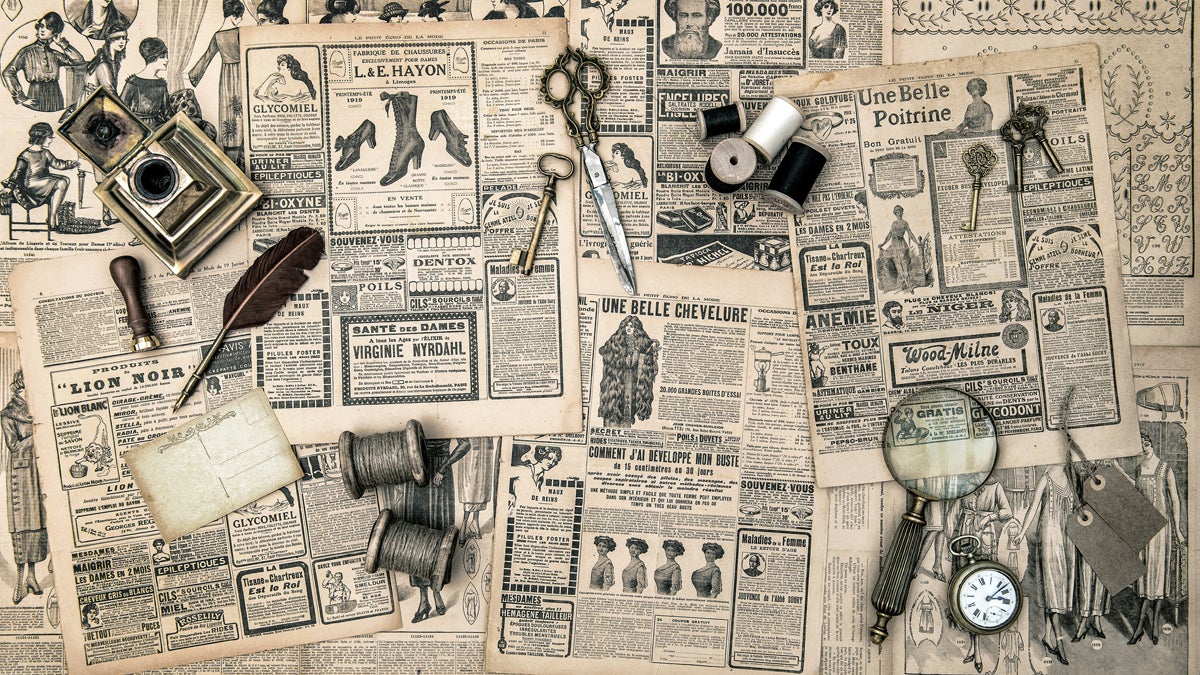Unpacking the pack rat to find art in the every day

(Ephemera image courtesy of Shutterstock.com)
Here’s how I used to judge art: The more it looked like I could make it, the less I liked it. My rule worked well for impressionism and modern art, but recently fell apart when I discovered ephemera.
Here’s how I used to judge art: The more it looked like I could make it, the less I liked it. Claude Monet’s water lilies? Magnificent! Jackson Pollock’s paint-splattered canvases? Too much like spin art I made on the Ocean City boardwalk. Piet Mondrian’s grids of primary color? Give me a few Crayolas, a straight edge, and a little time.
My rule worked well for impressionism and modern art, but recently fell apart when I discovered ephemera. Visiting Ephemeral Sprawl II at the Print Center, I saw something I both admired and have made. Comprising themed collections, the exhibit transports viewers in time and into the minds of the collectors. Displayed in shadow-box cases, groups of paper items are by turns interesting, nostalgic and curious — a lot like things I’ve saved in folders and shoeboxes, just more orderly and better lit.
Art and artifact
In art, ephemera are transitory written or printed materials not meant to be retained or preserved. According to British Ephemera Society founder Maurice Rickards, they “reflect moods and mores of past times in a way that more formal records cannot.” The Print Center presentation of contemporary printed ephemera includes an eclectic assortment — 3-D bubblegum cards; feminist books and pamphlets; flyers announcing performances of Plastic Little, a rap group; archival material from Cindergarden, a West Philadelphia commune; and 33 versions of George Orwell’s book Homage to Catalonia.
Preserving the disposable
Rickards defined ephemera as “the minor transient documents of everyday life.” Their very impermanence lends ephemera historic value, not in the grand sense, but in an on-the-ground way. Those house-and-garden magazines in Aunt Margaret’s attic, for instance, reveal what homeowners aspired to in a specific era. Just as old receipts stuck in Uncle Fred’s glove box provide tantalizing details on him, how he lived, what he valued.
History aside, ephemera have long been collected and preserved as art. The French ephemera society, Le Vieux Papier, dates from 1900. Rickards’ Ephemera Society of Britain followed in 1975, and the Ephemera Society of America was established in 1980.
A flexible definition
Though newer forms have emerged, ephemera are typically paper. Most agree that greeting cards, posters, tickets, receipts, and bookmarks are ephemera, but part company on postcards and stamps, which are differentiated because they are collected exclusively by so many.
Formal correspondence is not ephemera, scribbled lists are, and souvenirs are on the border. Some say that souvenirs masquerade as ephemera because they are really made to be kept, and therefore lack the requisite transience.
Ephemeral items in the collections of the Philadelphia History Museum, include an engraving of currency from Benjamin Franklin’s print shop and a program from a 1912 Philadelphia Orchestra performance conducted by Leopold Stokowski. Not earth-shattering documentation, but interesting, informative, and worth preserving.
As information media have advanced, snippets of audio and video have been recognized as ephemera. For example, the short films from the Philadelphia City Archives that have recently become available on You Tube could be thought of as video ephemera.
Capturing fleeting moments
Whatever form they take, ephemera are slivers of personal pasts that intersect with formal history. Some of the items in Ephemeral Sprawl II are undated, which is unfortunate. Knowing when items were produced, used, and collected adds to the viewing experience, particularly for those too young to remember the eras represented.
We are all artists of the ephemeral. Who doesn’t have a collection of matchbooks or movie stubs, autographs or airport luggage tags, this-and-thats, saved for remembrance, beauty, or proof? Everyday detritus, saved accidentally or on purpose, preserves what would otherwise be forgotten. However they are composed and whatever they contain, ephemera depict people and moments. They remind the world of what we were about when no one was looking.
—
Ephemeral Sprawl II, through August 2, 2014, The Print Center, 1614 Latimer Street, Philadelphia, PA 19103, 215-735-6090, www.printcenter.org
WHYY is your source for fact-based, in-depth journalism and information. As a nonprofit organization, we rely on financial support from readers like you. Please give today.

